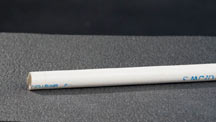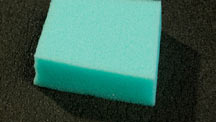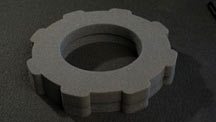

SUPPLIES
|
||
 |
DAP Contact Cement This is a wonderful adhesive if you use it right. Coat each surface to be adhered using a sponge brush. Make sure to cover the whole area with an even coat but don't put it on too thick. Wait for 10 minutes or more until the contact cement no longer looks wet. It should be very tacky but should not come off on your finger when you touch it. It's better to wait longer than to combine the adhesive surfaces too early. |
|
Spray Adhesive Spray liberally on each surface to be adhered and wait for 3-5 minutes or more until the adhesive is aggressively tacky. It needs to feel sticky but not come off on your finger when you touch it. Great to use particularly on porous materials like cardboard and open-celled foams. |
||
| Silicone 100% silicone caulk is a very strong adhesive and has the added benefit of remaining flexible even after it is dry. It takes longer to dry than the other adhesives above but is a great tool to have around. |
||
 |
Tape This will be the foundation of your weapon building tools. Duct tape is the main tape used for structural support. It adheres excellently and is a strong tape with very little stretching. Cloth tape is also valuable - these include Hockey tape (first choice) or a good athletic tape. These tapes are used mainly for areas that are held in your hands. They are a comfortable surface and look cool too. |
|
 |
Tools You don't need lots of different tools to make any of these projects but some things are always good to have around. Medium coarseness sandpaper is important for working with PVC and wood. Foam brushes are an inexpensive brush for using Contact cement that you can just throw away when you are done. A retractable razor utility knife in invaluable. You can get a cheap one for $.99 at Wal-mart. |
|
 |
PVC This is the low cost, easy to find, weapon core of choice. You can cut it easily with a jigsaw, hacksaw or any saw with small teeth. 1/2" is most often used in our projects but some weapons may call for 3/4". It can be found at any home improvement center or hardware store. |
|
 |
Open-Cell foam (regular density) |
|
 |
Open-Cell foam (High density) This greenish foam can be found at fabric stores or most places that carry upholstery supplies. It is a little costly but good for use with weapon manufacturing. Used mainly to pad projectile weapons (arrows, javelins, etc.), some shield designs and sword tips. It can be easily cut with a razor blade or serrated knife. Spray adhesive is the glue of choice for open-celled foam. |
|
 |
Open-Cell foam (Very High density) |
|
 |
Open-Cell foam (Packing foam or Charcoal foam) Many feel that this type of foam is ideal. You might recognize this as the type of foam used in padded equipment cases. It can be quite firm and still is the most lightweight of the open-celled foams (it can cost less than the green foam too). I'm not aware of local stores that carry it but you can find it readily online ( www.foambymail.com ). Shown are two gaskets that came with air purifier filters - I made them into foam chakrams. |
|
 |
Closed-Cell foam It can be easily cut with a utility knife or serrated knife. DAP contact cement or spray adhesive work well with this foam. |
|
 |
Swim Noodles The main problem is finding them. They are easy to find it the spring and summer and only cost about $1.50 but you might only be able to find them on the internet in the winter time. |
|
 |
Pipe Insulation It's quite inexpensive and can be found at home improvement centers in 6' lengths for about $1.50 or less. |
|